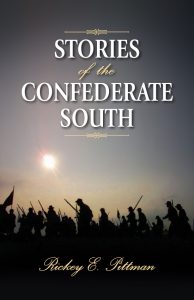My publisher has sold out of this book, so as a free copy, it is now available in PDF form. Just click on the cover and download it. Alba gu bràth!
Free PDF download of Stories of the Confederate South!
My book, Stories of the Confederate South is out of print, but to my writer friends, especially those interested in history, I’m offering this free PDF download. I hope you enjoy it! Just click on the book cover or follow one of the two links below to receive this collection of historical fiction.
https://bardofthesouth.com/wp-content/uploads/storiesconfedsouth-1.pdf
Chicken Little and the Climate Crisis Part 2
Chicken Little and the Climat Crisis Part 2
by Rickey Pittman
The sky is falling,
Said Chicken Little,
We’re destroying our planet,
Little by little.
Something more must be done,
To end the use of fossil fuel,
Electric cars are the way to go,
Say activists who sound like fools.
Yes, our predictions were wrong,
As to when the world will end,
>Predictions we’ll never bring up,
New ones we can easily spin.
We used to call it Global Warming,
But that model failed us too,
So now it’s just Climate Change,
Yes, that’s vague, but it will do.
Our leaders warn of Climate Change,
But they don’t really believe,
Flying around in their personal jets,
And build huge mansions by the sea.
Politicians and most media,
Take our side on this,
So be afraid, very afraid,
This crisis don’t dismiss.
The Green Deal Machine works hard,
To insure your cooperation,
Quit driving your gas-fueled cars,
Or we’ll face starvation!
Chicken Little and the Earth Climate Crisis: Part 1
Climate Change Hysteria and Modern Day Chicken Littles
Since the early years of the 19th century, the story of Henny Penny, better known as “Chicken Little,” has a central phrase, “The sky is falling.” The phrase is now applied to people who are unreasonably afraid, or those trying to incite unreasonable fear in others, i.e., fearmongering. These are people who predict calamity, especially if there’s no real evidence or justification for the claim. Does this phrase not easily describe those behind the climate change hysteria?
 The phrase “Chicken Little” became very popular in the U.S, after Chandler published his illustrated children’s book in 1840. I’ve attached a photo of the book’s cover.
The phrase “Chicken Little” became very popular in the U.S, after Chandler published his illustrated children’s book in 1840. I’ve attached a photo of the book’s cover.
The climate crisis fanatics would certainly qualify to be modern-day “Chicken Littles.” By the way, none of their predictions of the end of the planet have come to pass, and the ELITE politicians who promote the Green Dream are often the greatest violaters of Green ethics, using private planes, etc. The climate change disciples who in their disruptive and destructive protests call for more administrative actions, certainly sound like the original Chicken Little. While willing to punish America and force Americans to change their lifestyews, they are unwilling to see how the changes they want will not save our planet, especially as long as the major world violators (China, India, and probably many others) of the increasingly weird climate change doctrine do not follow their guidelines.
The Chicken Littles of today have declared war against fossil fuels (they really don’t want you driving around), promoting the illogical electric cars (much more expensive than gas autos. See image below) who don’t realize who their idiot-ology will ruin the farmers who feed America.
Of course, if one has no car one depends on for work, no real personal responsibilities, and PLENTY of money, the hardships caused by the Green Agenda are no big deal.

Book Review: Sins of a Cajun Boy by Danny Singleton
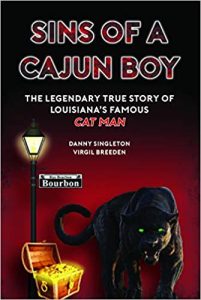 The Cajun Prairie Author Expo at LSU-Eunice, (July 23rd) featured over twenty Louisiana authors. It was at this event that I met Danny Singleton, the author (along with Virgil Breeden) of Sins of a Cajun Boy: The Legendary True Story of Louisiana’s Famous Cat Man. I obtained a signed copy. The book is a quick read, with forty-one chapters. The book is a memoir, a descriptive account of a man’s life of crime, and a remarkable tale of redemption. Singleton was a skilled safecracker jewel thief, and cat burglar, whose criminal career tied him to the Dixie Mafia and to criminal organizations in Florida Alabama, Louisiana, and Texas and landed him in several prisons, including Angola, Parchman Farm. He describes his restless life as a search for the dragon. Larceny certainly ran in his blood.
The Cajun Prairie Author Expo at LSU-Eunice, (July 23rd) featured over twenty Louisiana authors. It was at this event that I met Danny Singleton, the author (along with Virgil Breeden) of Sins of a Cajun Boy: The Legendary True Story of Louisiana’s Famous Cat Man. I obtained a signed copy. The book is a quick read, with forty-one chapters. The book is a memoir, a descriptive account of a man’s life of crime, and a remarkable tale of redemption. Singleton was a skilled safecracker jewel thief, and cat burglar, whose criminal career tied him to the Dixie Mafia and to criminal organizations in Florida Alabama, Louisiana, and Texas and landed him in several prisons, including Angola, Parchman Farm. He describes his restless life as a search for the dragon. Larceny certainly ran in his blood.
He relates in his story the individuals and life events that shaped his criminal career and that eventually led him away from crime and to a positive life of faith and service. Though he experienced much suffering and setbacks in his life, his book ends positively without bitterness. The book includes several newspaper articles relating to his crimes and court cases.
To order his book and to learn more about this fascinating man, his story, and his present Christian ministry, order his book HERE:
The Scots & Irish in Louisiana: In Story and Song
The Scots & Irish in Louisiana: In Story and Song
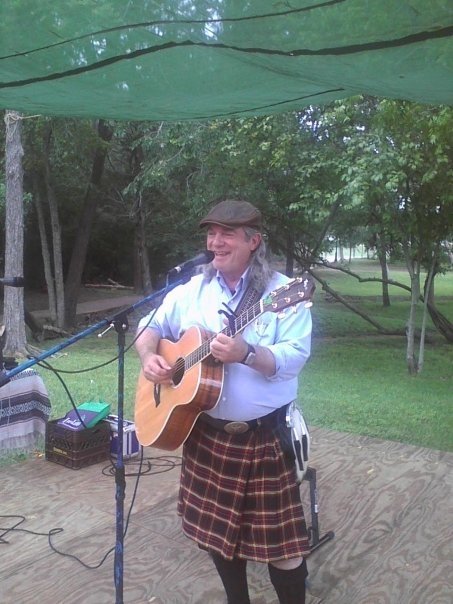 A presentation by Rickey Pittman about the influence, notable individuals, settlements, and achievements of the Scots & Irish in Louisiana. Presented July 9, 2022, in Alexandria, LA.
A presentation by Rickey Pittman about the influence, notable individuals, settlements, and achievements of the Scots & Irish in Louisiana. Presented July 9, 2022, in Alexandria, LA.
THE IRISH
-
- According to 2014 estimates from the U.S. Census Bureau’s American Community Survey. Louisiana has more than 351,000 people claiming Irish ancestry, about 7 percent of the state’s population.
The Irish (and the Scotts) left their mark on the state’s geography. Delhi, Kelley, Tullos, and Jena (formerly Hemp’s Creek) are all named for places in Ireland. Native American mound sites in the region have Irish or Scottish names. Galloway, Kilbourne, and Balmoral are just a few examples.
Hibernia Bank, once the largest local bank in Louisiana. (The Ancient Order of Hibernians is the largest and oldest Irish Catholic organization in America.) Numerous Irish pubs can be found in greater New Orleans area.
-
- WHY/HOW DID THEY COME TO LOUISIANA?
The potato famine 1820-47 (approx). Because of prejudice, many were turned away from northern ports. Charged $1.50 per person to board a ship and were required to bring a bed or casket. Ships came to England with cotton bales as cargo, so on the return voyage, they used them as ballast. Louisiana was Catholic friendly and anti-British. In 1860 census, close to 30% of NO residents were born in Ireland.
A landmark of Irish influence is the statue of Margaret Haughery on the corner of Prytania and Camp streets. Margaret Haughery was a destitute Irish immigrant who became a prominent businesswoman and philanthropist in the city. When she died in 1882, she was widely mourned. In commemoration of her good works, this statue of her comforting an orphan was erected soon after, said to be the first American statue honoring a woman.
The most iconic Irish cultural landmark is Patrick’s Church founded in 1833, this Gothic church is now a National Historic Landmark. Once a center of Irish immigrant life, Irish descendants are still in its congregation. With beautiful stained glass, wood plaster details, and vaulted ceilings, St. Patrick’s is one of the oldest buildings still standing in the Central Business District. Parishioners wanted to attend services in English, not French, Spanish or Latin. They wanted a place where God spoke English.
Completed in 1857, St. Alphonsus served as a Roman Catholic church for the Irish Catholic community of the Lower Garden District section of the city.
The Irish Canal: Hired to dig with pick and shovel the mosquito-infested ditch that would be the new 60-ft. wide 6.07 mile-long shipping canal to Pontchartrain. There was no dynamite, nothing but wheelbarrows with which they’d haul the sludge out of the ditch on inclined planks. And there was no way for them to drain the relentless seepage but with pumps. Over 8,000 died from disease and exhaustion, buried along the way in shallow graves or in mass graves at St. Patrick Cemetery No. 1. The builders of the city’s New Basin Canal expressed a preference for Irish over slave labor for the reason that a dead Irishman could be replaced in minutes at no cost, while a dead slave resulted in the loss of more than one thousand dollars. Irish workers made up half of the crews of riverboats and dock workers.
The Irish Channel – Named for the wave of Irish immigrants who settled there. My son lived there for a while. Here’s a good guide: https://www.neworleans.com/blog/post/irish-channel-neighborhood-guide/
The Irish Cultural Museum: Programs, special speakers, musicians, historical displays. On Conti Street. Coffee House. https://www.facebook.com/IrishCulturalMuseumOfNewOrleans/
Block Parties, St. Patrick’s Day Parade, Mardi Gras: Krewe of Erin, Krewe of St. Patrick
Irish Dancers: Many schools of Irish Dance in greater New Orleans area.
Irish Theatre and comedy: Drama has an interesting history in New Orleans. Camp Street Theatre, St. Philip Theatre, and St. Charles Theatre especially featured Irish plays: The Irish Tutor (7 seasons), Audiences saw plays about Irishmen in every possible profession or situation, such as: The Irish Ambassador, The Irish Valet, The Irish Heiress, and The Irish Widow; and in locations around the world: The Irishman in China, The Irishman in London, The Irishman in Naples. The Irish Ambassador and The Irish Lion. New Orleans theater-goers were a receptive and enthusiastic audience. Songs were regularly encored. Covered well by newspapers.
Famous actors: Barney Williams, John Collins, Tyrone Power, Master Joseph Burke, Dion Boucicault and John Brougham, Richard B. Sheridan, Robert Emmet . Power had goal of keeping the audience in a roar of laughter with his jokes, brogue, blarney, and botheration whether he performed in plays he wrote or in those featuring songs and dances written expressly for him.
Irish eccentrics, stereotypes, blunders, farces, a comic dramatic work using buffoonery and horseplay, bulls. An Irish bull is a ludicrous, incongruent or logically absurd statement, generally unrecognized as such by its author. Very similar to our Boudreaux and Thibodeaux. Family groups, The Young Irish Minstrels, (Professor MacEvoy and his 3 colleens) Raymond Family (an hour in Ireland) keep interest in Irish music going.
Catherine Hayes, “The Irish Skylark.” was a world-famous Irish soprano of the Victorian era. On February 21 the Irish militia companies, benevolent societies, and temperance organizations marched to the Armory Hall and attended her concert in a body. Catherine Hayes earned four hundred dollars nightly for her concerts in February 1852.
THE SCOTS: There are 20 cities and parishes with Scottish names in Louisiana. Numerous businesses, schools, mascots (Scotties, a highland breed) streets named Cameron, Stewart
Scottish Free Masonry, lodges proudly proclaim their Scottish heritage.
Tartan Day (Minden) A festival and sometimes celebrated at Presbyterian churches. Tartan Day is a North American celebration of Scottish heritage on 6 April, the date on which the Declaration of Arbroath was signed in 1320.
Highland Cattle Association: Prices ranged from crossbred steers at $800 to a registered yearling Highland bull for $14,000, and a registered six-month-old Highland heifer sold for $12,500. Then for the unregistered an open 4 yr. old cow, sold for $9000. Prices were high also for cow/calf pairs selling for $6200. Coos (excellent lean meat for burgers) They have a Highland cattle auction! One can purchase meat online.
Pipes & Drums groups
Scottish Dances and dancers: https://www.rscds.org/learn/steps-techniques/simple-scottish-dances
Ceilidh Dancing
Scottish Society (Caledonian Society in Baton Rouge) https://www.csbr.org
(Coterie) https://www.csbr.org/homepage/the-scottish-cultural-society-the-coterie/ a small group of people with shared interests or tastes, especially one that is exclusive of other people
Scottish Marshall Arts – “Broadsword society,
Robert Burns Birthday Jan 25. The main attraction of Burns Night is the Burns Supper. This traditionally involves participants donning tartan, listening to bagpipes, crooning Auld Lang Syne – also sung at New Year’s Eve – and reciting the great writer’s songs and poems.
St. Andrews Patron saint of Scotland (Nov. 30) St Andrew’s Day celebrates the very best of Scottish culture with lots of delicious food and drink, music and ceilidh dancing, with parties going into the wee small hours of the night.
Whiskey Tastings (whisky spelling) How to do a whisky tasting! https://www.whiskyadvocate.com/do-whisky-tasting/
Highland Games and festivals. There are many vendors with Scottish costumes, food, flags, and other items.
SCOTS-IRISH (Ulster-Scots: the rednecks of the Celtic World)
-
- How they started: After the North of Ireland was de-peopled, Scots were imported in great numbers to resettle the land. They were largely protestant. (Thus Civil war between north and south) The peak periods of Scots-Irish immigration to America occurred between 1718-74 https://discoverulsterscots.com/emigration-influence/america/ulster-scots-america/scotch-irish-and-new-orleans
Known as a ‘God-fearing, Sabbath-keeping, covenant-adhering, liberty-loving and tyrant-hating race.’ This love of freedom is a regular theme in centuries of Scotch-Irish literature. Jackson Square is named for Andrew Jackson, whose parents were Scotch-Irish emigrants to America in the 1760s.
A good link on the Ulster Scotts. https://discoverulsterscots.com/emigration-influence/america/ulster-scots-america/scotch-irish-and-new-orleans. (Thomas Mellon)
Oliver Pollock, Ulster Scot, invented the dollar sign, one of the wealthiest merchants in America. Spent almost a billion supporting the Revolution.
Central and North Louisiana were settled by the Scots-Irish immigrants from Georgia, Alabama, South Carolina, Mississippi, and Tennessee. The majority of these immigrants were Baptist or Methodist. They were usually small farmers with a strong Protestant work ethic, and few of them owned enslaved Africans.
Bard of the South to visit Shreveport
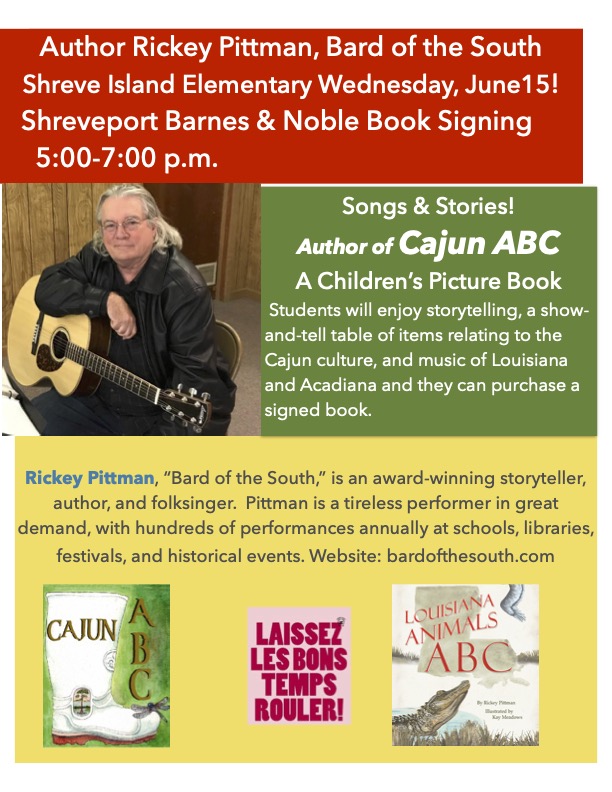
Rickey Pittman, Bard of the South Book Signings!
Feel free to share this information! If you are near one of these Barnes & Nobles, stop by for a visit! I’d love to meet you in person!

Clean Nets: A short story by Rickey Pittman
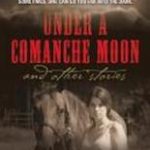
Clean Nets
Ever since Indian Territory days, my family has fished this Red River. Mama always said there ain’t no call for us to be ashamed of it neither. She says the first apostles were fishermen, and that if fishermen are good enough for Jesus, then the rest of the world will just have to accept us too.
When they finished the Lake Texoma Dam in 1944, the Red River changed, and our family had to change with it. Now, most of our fishing time is spent on the lake. We also started guiding some, helping those tourists with more money than sense to catch sand bass or stripers, or get them to some ducks and geese in hunting season. They’re surprised we ain’t got no fish sonar or duck radar or fancy gear like that. We just know where the fish are and where the ducks like to go. Ain’t really much to it if a man pays attention.
The life of a fisherman ain’t as simple as it used to be. Now I gotta fool with getting all kinds of permits.
My daddy fishes with us some. He still cain’t read, so I have to read each year’s new rules to him. The state says we gotta count and measure fish, and throw back the game fish if they get tangled up in my nets or traps or get on my trotlines. I have to throw them back even if they’re gonna die. Seems like a waste of good fish. Sometimes I keep them anyway and take them over to Hendrix and give them away to the colored people there. I guess that’s okay, long as I don’t sell them. Sometimes I wonder what these state bureaucrats are thinking. If they’d just talk to a fisherman, they’d get lots of ideas. But I reckon they don’t care for talking to someone who knows how to do something they are passing laws for. No one used to pay us fishermen much mind. Now, we get more attention than I care to have from all kinds of folks, but mostly from rabbit rangers who seem set on catching us breaking some crazy law someone thought up.
Yet, I ain’t got it as bad as some. I read one story of some fellows that got put in the pen for importing half a dozen lobsters that were an inch or so too short. The paper said that government prosecutors worked on this case for six months. Seems like six months of detective work and lawyers would have cost a passel of tax dollars to prosecute
this lobtsergate conspiracy. I hope they don’t get so desperate to keep a job that they would pick on poor fishermen like myself.
We make most of our money off the catfish we sell, but I noticed it’s getting harder to sell them. People are getting attached to that pond-raised catfish, or lately, that catfish or tapia that comes frozen all the way from China. But they don’t taste the same as river fish. Anyone raised on river fish can tell you that.
But what a lot of folks don’t know is that we got all kinds of good fish here, not just catfish. There’s brim, largemouth bass, crappie, gar, drum, buffalo, carp, black bass, sand bass, stripers, hybrids (I reckon a hybrid happens when a sand bass gets to know a striper real well), and spoonbill catfish that we snag down by the dam when the rabbit rangers ain’t around. We eat’em all too.
But even though I spend a good bit of my fishing time on Lake Texhoma, and she works me near to death, I still love that damned old Red River. She’s toned down some since the dam was finished, but she’s still got a mind of her own. She don’t flood much no more, like she did when she devoured the town of Karma, north of Bonham where my grandma had a store. Grandma told me how she and my grandpa just watched the river warsh the whole town away. Weren’t nothin’ they could do bout it. And there ain’t nothin’ lives there now. Lady Red must not have liked that town much.
The river used to have a bunch of logjams, but they’re pretty much all gone now. Daddy said that in his day the logs were so thick you could walk across the river and never get your feet wet. The river’s still got quicksand, even though it ain’t as bad as it was. I don’t know where it went to, but only a few spots are bad to have it now. People who don’t know about quicksand or can’t spot it are in bad shape if they get caught in it alone. It must be horrible for someone to get drownded in mud, being sucked down to the river’s bottom. I only got in quicksand once. Daddy hauled me out and told me how the last person he pulled out of quicksand was a woman, and he had to reach down and pull her out by the hair. She was real dead, he said. And then after making me take a close look at the quicksand, he whipped my little ass with a willow switch real good so I’d remember not to come near it again. I learnt right then what quicksand looked like and I ain’t stepped into it since. A good thrashin’ always helps the memory.
When the water’s high enough, I load up the kids and their grandaddy on the johnboat or airboat, and take them downriver, explaining to them all they need to know ‘bout the river nowadays. When the water’s too low for a boat, I walk its banks on Sundays. Sunday is the only day I don’t fish; it’s the only day our family ever took off from work. I find stuff—old bottles, lots of trash that I guess came down from the dam, ‘cause I sure don’t see no people around to leave it there. Sometimes I think the river’s got a mind of her own and just puts things where she wants when she’s tired of playing with it.
Mama says the river used to be haunted. Gave people some kind of fever that made them start killing folks. Ever time some good ole boy goes on a killin’ rampage, Mama says that the fever’s come back to the Red River Valley. “If’n you ever see someone who don’t belong down there, you be real careful,” she says. “Look at their eyes. The ones with the fever got the same look as a wild dog that ain’t afraid of humans no more.”
“How do people get well from this fever, Mama?” I asked.
“Ain’t but one cure,” she said. “They got to be put down, just like they’s a rabid dog.”
I think that fever’s been around now and then because my family’s found several dead bodies on the river or in the lake through the years. Drownings mostly. Some of them could swim, but they underestimated the strength of the current and the temperamental nature of the river. Sometimes I think she just don’t care for people thrashing around in her and gets riled up and pulls them down. Some of the others I just don’t know how they got there cause they still got their shoes and fancy city clothes on. You can tell they didn’t fall off no boat.
My house ain’t far from the Carpenter’s Bluff Bridge. We see folks down there in summer swimming and diving off the bridge. They go there at night too and build fires and drink and all. I couldn’t sleep one night and I floated down river, sittin’ in the front of the boat just sculling along, and I saw a bunch of folks underneath the bridge. They was sitting in the light of a campfire and I heard them carrying on.
Sounded like they were having a big time. When she’s a mind to, the river knows how to make folks real happy and feel like they belong there. Only difference between these visiting folks and me is that I belong on the river all the time.
My wife Sophie and I had us a bunch of kids, and all of them know how to fish. The littlest ones we teach to get bait. They seine crawfish out of ponds and ditches, dig worms, seine minners out of the creek and sell them so they can have some spending money. But I only got one out of the bunch that’s taken to fishing enough that I know he’ll be a fisherman all his life. When he ain’t in school, he’s with me. Elvin’s a tough one—you can tell by his callused little hands. He doesn’t cry when he gets wet or cold. He don’t mind getting his face blistered by the wind or sun. He works right beside me until the fish are all cleaned and we get everything ready for the next day.
One day we was warshin’ and mending our nets and he says, “You must have the cleanest nets in the river, Daddy. Why you warsh them so much?”
“Dirty nets don’t catch no fish, boy.” Then I tell him what my daddy always told me. “When Jesus called them first apostles, they was warshing nets when he found them. So right away he called them to follow him, ‘cause he knew they were good fishermen. They kept fishing too, only from then on they fished for men. A man’s got to keep his nets clean in life, boy, if’n he wants anything in them but trash.”
We was on the river one afternoon and my boy was walking the sandbars and stepped into some quicksand. I hauled him out of it and whipped his little butt with a willow switch, just like my daddy done me. And I explained to him how the river, she don’t cotton to a man bein’ careless. He’s got to pay attention all the time. I told him how the river’s different now, and how she’ll be different when he’s growed up too. Maybe then she won’t have no quicksand at all, but she does now, and he cain’t go messin’ around in it.
I don’t know why my family likes fishing so. I guess we were just meant to do it. But I know when I feel that tug on my line, and I feel that life there, it feels real good. And when I can sell a pickup load of iced-down catfish to the grocers, and go back home with money, it
makes me feel good to buy my family things they need. Good fishing goes in spells, so I don’t always catch as much as I want. Sometimes the river pushes the fish away from us just to see if we love her enough to stick with her. She ain’t run us off yet. Hell, we ain’t goin’ nowhere.
Two Girls in a Persimmon Tree
This is a song I just wrote about my mother—a true story. It is a first draft, so pardon cadence and meter and other issues. I’m probably going to add a chorus to it.
“Two Girls in the Persimmon Tree”
Mitty Beth & Jessie Fae,
Were swinging from grapevines,
Pretending to be Tarzan & Jane,
Having a real good time.
Let’s go fishing, said Jessie Fae,
And a smile came on her face,
I heard the fishing’s good,
In the pool on the Parker place.
Jessie Fae & Mitty Beth,
Went fishing that fine day,
The crossed the fence at the Parker place,
Mitty Beth and Jessie Fae.
They walked into Parker’s pasture,
With bait and fishing poles,
Two country girls out for some summer fun,
To their favorite fishing hole.
The Parker cows had a bull,
They called him Billy the Kid,
Many had tried to ride him,
They tried, but never did.
Sometimes he serviced Parker cows,
When not in rodeos,
But both brought out the mean in him,
Why, I do not know.
Jessie Fae and Mitty Beth,
Saw the bull coming their way
He pawed the ground & lowered his head,
Making the girls afraid.
They climbed up in a persimmon tree,
To escape the angry bull,
They picked the tree’s sweet fruit,
And ate till they were full,
Have you ever eaten persimmons,
After first frost has come?
All the bitterness is gone,
There’s just sweetness on your tongue.
The girls sat until the sun went down,
But the bull, he wouldn’t leave,
He lay down to wait it out,
Till they left the tree.
Their mamas began to worry,
As the sun was setting low,
So they sent the Beechum boy,
As fast as he could go.
Beechum ran the bull away,
And the girls climbed down the tree,
‘They asked for a ride on his horse,
He said, “You’re kidding me!”
Go back home the way you came,
I’ve got better things to do.
Your mamas might tan your hides,
So I’d hurry if I were you!”


